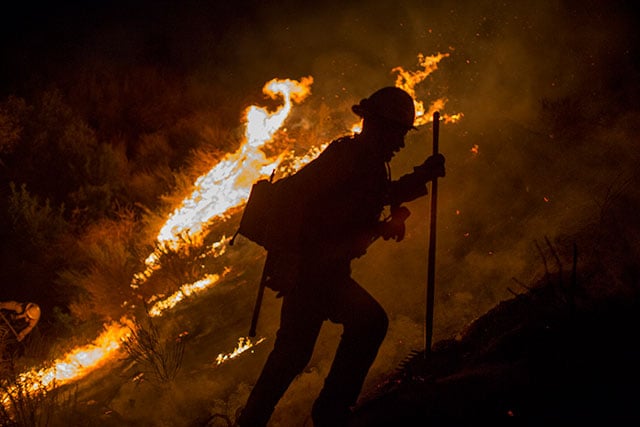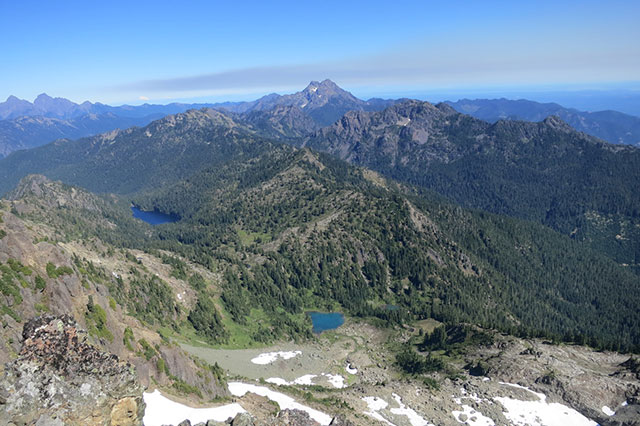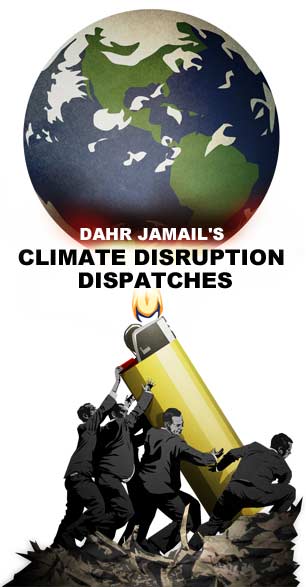
On Sunday, August 27, I went mountain climbing in Olympic National Park, near my home. I noted how warm the day was — far warmer, even in early morning, than the norm for this time of year. I would learn that evening that across Puget Sound in Seattle, the city had seen temperatures an average of nearly 10 degrees above normal that day.
When I reached the top of the peak and looked to the northeast, a massive smoke plume from wildfires to the south clouded the horizon nearly all the way to the Canadian border. The Pacific Northwest has spent much of the summer covered in smoke from wildfires raging across British Columbia, but now the smoke is coming from the south as fires rage across the American West.
 Wildfire smoke over Puget Sound in Washington State. The smoke is from massive fires in Oregon. (Photo: Dahr Jamail)
Wildfire smoke over Puget Sound in Washington State. The smoke is from massive fires in Oregon. (Photo: Dahr Jamail)
The day was warm enough that drinking three and a half liters of water felt like barely enough to get me back down to the trailhead. While driving home, I listened to NPR, the only radio station I could pick up. The news focused on Tropical Storm Harvey and the epic flooding in Houston. That Sunday, the area flooded in Texas was, staggeringly, the size of Lake Michigan. Several people had died, and 450,000 Texans were expected to seek disaster aid, as more than half a million homes have flooded in Houston.
To see more stories like this, visit “Planet or Profit?”
The flooding there has been and continues to be catastrophic, as the warming waters of the Gulf of Mexico fuel greater and greater storms, and the warmer atmosphere becomes that much more capable of holding moisture.
On NPR, anthropogenic climate disruption (ACD) was not mentioned in connection with this epic storm until a reporter from the Texas Tribune brought it up. And we wonder why ACD denial is as rampant as ever, including in a place like Houston, where some people are literally drowning from ACD.
Listening to this news, I drove home under the thickening cloud of wildfire smoke while worrying about my family members in Houston. This is life amidst abrupt, runaway ACD.
The Pacific Northwest is far from alone in grappling with unprecedented wildfires. You know rapid, dramatic changes are afoot when there are wildfires in Greenland, of all places.
The European Earth Observation Programme called the fires “rare,” and admitted to Wildfire Today that it actually had “no data on previous wildland fire activity in this region.” Hence, the fires are unprecedented.
 Several leading climate scientists have come out with a statement that underscores the fact that the Paris Agreement goal — limiting planetary warming to 1.5-2°C — is too little, too late, given that this goal would already be well above any temperatures experienced during the period of human settlement since agriculture began.
Several leading climate scientists have come out with a statement that underscores the fact that the Paris Agreement goal — limiting planetary warming to 1.5-2°C — is too little, too late, given that this goal would already be well above any temperatures experienced during the period of human settlement since agriculture began.
Former NASA climate chief James Hansen, along with co-authors cryosphere expert Eric Rignot, paleoclimatologist Shaun Marcott and oceanographer Eelco Rohling, concluded in a paper that, “the world has overshot the appropriate target for global temperature” because there are large risks in “pushing the climate system far out of its Holocene range.” (The Holocene is the epoch that began approximately 11,700 years ago.)
They said the fact that our current temperature has surpassed 1°C of warming indicates that we’re already half a degree warmer than the previous Holocene maximum. Our current temperature is as hot as it ever was during Earth’s previous warm period, the Eemian (130,000-115,000 years ago) when the “sea level was 6-9 meters (20-30 feet) higher than today.” The scientists warned of feedback loops kicking in that will raise sea levels by several meters, thawing of global permafrost, and significant loss of the polar ice sheets. Yet, while their warning was obviously meant to be in the future tense, we are already seeing each of these effects now.
Despite lacking the warming influence of an active El Niño, thus far, 2017 is on track to be the second-hottest year on record, with 2016 being the hottest, and 15 of the 16 hottest years recorded happening since just 2000. July was a record warm month for Utkiagvik, the northernmost city in Alaska, along with three other interior Alaskan cities: Bettles, Tanana and McGrath.
A recently published study predicted a death toll of 152,000 every year between 2071 and 2100 as a direct result of extreme weather events (heat waves, wildfires, floods, etc.), in Europe alone, if no serious action is taken globally to reduce greenhouse gas emissions or protect people. The study, by the European Commission Joint Research Centre in Italy, urged governments to focus now on designing adaptation measures.
Underscoring the rapidity of the changes we are already in, the leading British global investment firm, Schroders, with assets worth more than half a trillion dollars, released a warning to its clients that, if we continue consuming oil and gas at current rates, Earth is on course to experience temperature increases of nearly 8°C (14°F) by 2100. The firm’s head of sustainable research noted, “Climate change will be a defining driver of the global economy.”
Earth
Dramatic signs of abrupt ACD continue to make themselves more evident across the terrestrial sphere.
According to a recently published study, 2015 saw an area of forest the size of Nebraska burned or erased from wildfires, logging, and infringement from palm-oil plantations. The 49 million acres of disappeared forest were mainly in North America and the tropics, spurring global deforestation that year to reach its second-highest point since record keeping on this began in 2001. The study also showed that across the planet, 47 percent more forested land was lost in 2015 than was lost a mere 16 years ago. Wildlife continues to bear the brunt of these impacts.
The ability of humans to feed our ever-growing populations continues to look increasingly precarious. A recent report by the London-based think tank Chatham House shows how ACD is threatening the intricate network the world of humans uses to feed ourselves. The report details how the majority of the planet’s food is shipped through 14 “choke points,” and shows that if simultaneous extreme weather events that knocked out crops occurred in, for example, Russia and the US, starvation in areas that were heavily reliant upon those imports would be practically guaranteed.
On that note, a report in the journal Environmental Research Letters shows that ACD is directly reducing the amount of protein found in rice and wheat, thanks to increasing CO2 levels. Disturbingly, researchers who worked on the study said they still do not understand how or why CO2 emissions drain protein and other nutrients from plants. Yet this phenomenon could very well have catastrophic global consequences when it comes to attempting to feed Earth’s ever-burgeoning human population. This development may well leave populations already vulnerable to lack enough to eat at risk of early death and/or stunted growth.
Another brutal report showed how, across Africa, ACD is a key factor in diminishing the amount of land needed to grow food for the continent’s increasing populations. (Soil degradation, erosion and poaching also contribute to this decrease.)
ACD also takes a deadly psychological toll. A study published in the Proceedings of the National Academy of Sciences showed that nearly 60,000 farmers in India have committed suicide due to ACD impacts. Research showed that an increase in temperature of just 1°C on an average growing season day was associated with 67 more suicides, while an increase of 5°C was associated with 335 additional deaths.
The exclamation point to end this section is a mega-tsunami in Greenland that was triggered by a massive landslide, linked to unprecedented warming in June. A 100-meter-high wave wiped out a remote settlement there. A study published about the event warned that events like this could become more common as the planet continues to warm.
Water
Extreme changes have been afoot this summer in the watery realms.
Populations of seabirds are in a state of free-fall in the UK. A recent report showed that one of the most significant seabird colonies in the North Atlantic has seen a 99 percent reduction in kittiwake nests since just 1990, and puffins there have seen a 50 percent drop in the last 30 years, among declines across other species.
In the cryosphere, the forecast is looking similarly dire. In Greenland, which is currently the source of 30 percent of sea level rise, summer snows have not slowed the melting. A recent report also showed that scientists are now “very worried” that melting there might accelerate rising sea levels even faster than previously expected. This is because the warmer temperatures are causing algae to grow on the ice, hence darkening the surface — which means it absorbs more solar radiation, which warms it and speeds the melting even more.
Meanwhile, earlier this summer, a Finnish icebreaker set a new world record for making the earliest seasonal trip across the Arctic’s Northwest Passage. The ship, which left Vancouver on July 5, arrived in Nuuk, Greenland on July 29. The previous record was set in just 2008.
Not far from the northernmost point of land in Alaska (Utkiagvik), a “haul out” of Pacific walruses occurred near the village of Point Ley. Two thousand of the animals pulled themselves out of the water and crowded onto the land, thanks to disappearing Arctic summer sea ice. This is the earliest known “haul out” on record, and comes as sea ice loss is nearing record-low territory yet again.
In other news, drought continues to plague the world. The Guardian reported recently that nearly one million residents in Rome were facing water rationing, as lake levels across Italy were at record lows after the driest spring in six decades was followed by several heat waves.
The heat across Europe this summer has led to the worst droughts seen there for decades, which have devastated food crops across southern Europe. Countries like Italy and Spain have seen their crops of olives, almonds and pistachios, among others, decimated.
Also in Europe, Spain’s Tagus River is at risk of drying up completely as drought there persists. Millions of people rely upon that river for their water.
Back in the US, a flash drought across the US high plains may well have already wiped out half of this year’s wheat crop. The wheat-growing region of Montana and the Dakotas is one of the top wheat-producing areas of the entire planet, and it is exactly this area that the US Drought Monitor upgraded to “exceptional” drought by early August. In fact, NASA has predicted this area will be turned into desert in the coming centuries, or more realistically decades, as ACD progresses.
On the other end of the water spectrum, as the warming atmosphere is capable of holding larger amounts of moisture, flooding across South Asia has impacted a staggering 16 million people, killed hundreds, and at the time of this writing, was expected to worsen. The Red Cross stated that the floods were becoming one of the worst regional humanitarian crises it had seen for years.
Fire
Wildfires have set records in many places around the globe this year.
In Canada’s British Columbia, wildfires have burned more area than ever before. As of mid-August, nearly 900,000 hectares of land have burned.
At least 1,068 fires have burned across Europe so far in 2017, which is roughly triple the average per year for that continent. That means an area nearly twice the size of the country of Luxembourg has burned, as the fires are expected to burn more often, longer and hotter than ever as ACD progresses. Earlier in the summer in Portugal, 64 people died in a forest fire when they were trapped, and many died as they tried to flee in their cars.
In late July, a wildfire in southeastern France caused an evacuation of 10,000 people in just one night.
In the US, the West has been going up in smoke all summer long. Well over 37,000 fires have burned more than five million acres across the country. Fires across California, Montana, Oregon, Nevada and Idaho have been unrelenting, as scorching temperatures, dry conditions and high winds have caused firefighters to often work round the clock.
A 2016 Climate Central analysis showed, “that the annual number of large fires has tripled since the 1970s and that the amount of land they burn is six times higher than it was four decades ago.”
Air
This has been yet another summer of record high temperatures around the planet.
Shanghai, the most populous city on Earth with more than 24 million people, saw a day when the thermometer reached 105.6°F: its hottest day ever. Eight of the 12 highest temperatures there over the last 100 years have been recorded in just the last five years.
A major heat wave struck the Pacific Northwest in the US in early August, breaking several high temperature records: Medford, Oregon saw 109°F, Portland reached 103°F, Olympia, Washington reached 96°F, and Seattle saw 94°F.
Extreme heat waves that have the ability to kill people who are healthy, within hours, will be impacting portions of India within decades, according to recently published research. The report estimates that three quarters of India’s 1.7 billion people will be exposed to levels of lethal humid heat by 2100.
Denial and Reality
Under the Trump administration, there is never a dull moment in the ACD-denial world.
Trump has, of course, begun the process of withdrawing the US from the Paris climate pact. More recently, the administration disbanded a 15-person advisory committee on ACD that assisted policymakers in incorporating climate science into their long-term planning and coordinating efforts.
In what is clearly a full-court press on the issue, the administration is also advising staff at the US Department of Agriculture’s Natural Resources Conservation Service to use the term “weather extremes” in place of “climate change.” Another large example of their denial efforts came in the form of scientists leaking a draft of a report to the New York Times that concluded that US citizens are already feeling the impacts of ACD. The report showed that temperatures in the US had increased drastically since just 1980, and said, “Evidence for a changing climate abounds, from the top of the atmosphere to the depths of the oceans.”
However, a quickly mounting body of evidence shows us that climate disruption is not only a reality, but it’s occurring more quickly and intensively than expected.
A study recently published in Nature Climate Change showed that there is only a 5 percent chance the Earth will warm by only 3.5°F or less by 2100. (In other words, there’s a 95 percent chance it will warm by more than that amount.) Another study showed that even if all emissions ceased, the planet will still warm by another 2°F by 2100.
Lastly, for anyone who has any doubt that we are already very far along in the course of abrupt ACD, have a quick look at this 35-second video that illustrates the ramping up of planetary warming over the last 100 years.
Join us in defending the truth before it’s too late
The future of independent journalism is uncertain, and the consequences of losing it are too grave to ignore. To ensure Truthout remains safe, strong, and free, we need to raise $46,000 in the next 7 days. Every dollar raised goes directly toward the costs of producing news you can trust.
Please give what you can — because by supporting us with a tax-deductible donation, you’re not just preserving a source of news, you’re helping to safeguard what’s left of our democracy.